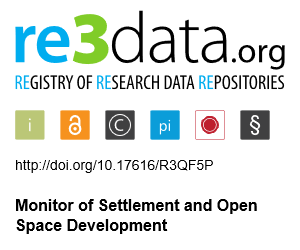News
| Date | Message |
|---|---|
| 15.06.2023 | The next DFNS will take place on 11.-12.06.2024 |
| 14.06.2023 | The Dresden Land Use Symposium (DFNS) came to an end today. The program included 4 keynotes, 30 presentations and 4 workshops. In addition to the current values of land take, monitoring results on settlement pressure in floodplains, land use for renewable energy, loss of agricultural land, arable farming in protected areas and organic farming based on InVeKoS data were presented. |
| 06.04.2023 | New land take decreased to 46.7 hectares per day in 2022 (value in 2021: 48.4 ha/day). |
| 24.03.2023 | Announcement of the foundation of the IOER Research Data Centre (IÖR FDZ), which will be established by 2025 of which the IOER-Monitor will be part of. |
| 01.03.2023 | Most indicator values are now available for the 2022 time series. |
| 04.01.2023 | The call for contribution to DFNS 2023 is now published for talks, workshops and posters. |
| 01.01.2023 | The IOER Monitor will integrated as a core data infrastructure and services within the IOER Research Data Centre, which is under development phase and will be appeared soon. |
| 10.11.2022 | Spatial planning regions (ROR) can be subdivided and zoomed-in by the boundaries of municipality, municipality associations and districts. |
| 01.09.2022 | In accordance with the announcement of 07/15/2022, updated figures for new land use for all available time periods (2011, 2013-2021) have been posted effective immediately. |
| 31.08.2022 | Based on current data (as of 4/2022) on floodplains provided by the Federal Institute of Hydrology and the responsible state authorities in Bavaria and Baden-Württemberg, the flood risk indicators have been recalculated for all time periods. The indicator "Proportion of the officially defined floodplain with built-up settlement and traffic areas" has been renamed "Settlement load in the floodplain" for better understanding. The information in the indicator sheet has been changed accordingly. |
| 18.07.2022 | The land productivity indicator was retroactively updated using updated data on economic performance for all time periods at the level of the federal states and districts and independent cities up to and including 2019. |
| 15.07.2022 | Due to the increasing influence of the migration to GeoInfoDok 7.1. from 31.12.2023 on the ATKIS Basic DLM, the indicators on land take will be recalculated for all years from 2011 onwards. The results will be published for all territorial units including raster data in WebGIS and by service call on 01.09.2022. Further details |
| 14.07.2022 | The indicators of the Risk category were recalculated for all time periods using updated data on officially designated flooding areas. With the exception of the state of Brandenburg, for which there is no complete state-wide designation of flooding areas, the figures are available on all administrative territorial boundaries and can be retrieved via WebGIS and OGC service. |
The IOER Monitor is a permanent scientific service within the framework of the research-based Political and Social Consultation Service of the Leibniz Institute for Ecological Urban and Regional Development (IOER).
This expert information system is intended to assist scientists, administrators, practitioners from business and industry as well as the general public to answer questions regarding ground cover and land use for the whole of the Federal Republic of Germany. It provides base data for the analysis of land use development, particularly regarding the issue of sustainability.
The data can be used in own projects. Please regard the terms of use and read more in the FAQ.
Which insights are provided through the data?

Further information
Land-use classification scheme of the IOER Monitor
The land-use typology of the IOER Monitor is based on the principle that all land-use classes are exclusive, which means that each part of the earth surface is assigned to exactly one land-use category. Thus, the aggregation of the main land-use classes Settlement, Open Space, and Transportation equals to the total study area. Each of these three top-level categories is subdivided into further differenciated land-use classes. Read more...


